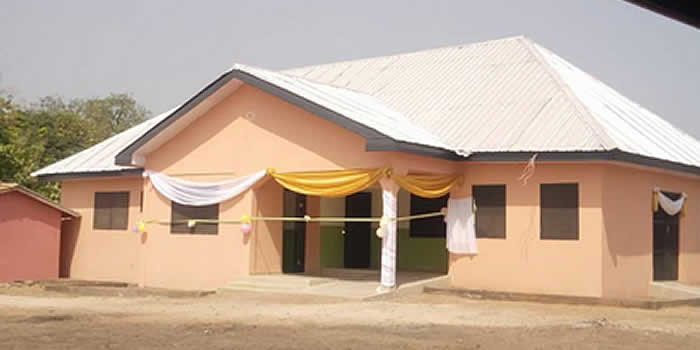

Development goals and Objectives
The development focus of the district is to provide basic socio-economic infrastructural facilities for sustained increased productivity, poverty reduction and improved living standards of the people in the district. A consensus was reached that the district’s goal is highly compatible with the national goal.
The District goal compared to the National Goal shows that the District goal has a strong correlation with the National goal as it has strong relation with all the National thematic areas.
The sector specific goals formulated to arrive at the District broad goal under the GSGDAII are as follows:
A. Enhancing Competiveness in Ghana’s Private Sector
· Improve facilities at market centres
· Enhance/improve access to credit/loan facilities
· Develop micro, small and medium scale enterprises
· Develop the tourism potentials of the district
B. Accelerated Agriculture Modernisation and Sustainable Natural Resources Management
· Improve the overall performance of the agriculture sector in the district
· Ensure sustainable natural resources exploitation and management
C. Infrastructure, Energy and Human Settlement
· Improve the roads conditions in the district
· Improve access to ICT facilities
· Improve access to reliable electricity supply
· Improve access to potable water supply
· Improve environmental sanitation and personal hygiene
· Develop planning schemes/development control measures
· Provide adequate and comfortable office and residential accommodation for District Assembly staff and other departments
D. Human Development, Productivity and Employment
· Improve academic performance
· Ensure quality health care delivery
· Reduce the spread of HIV/AIDS
· Reduce high population growth rate
· Create employment opportunities for the people
E. Transparent and Accountable Governance
· Strengthen sub-district level structures
· Reduce/eliminate worst forms of child labour
· Enhance and sustain women participation in decision – making at all levels
· Enhance and sustain girl child education at all levels
· Increase support for the vulnerable and excluded
· Create Revenue Database of the Assembly
· Organize and intensify Revenue Mobilization Campaign
· Organize In-service Training for Revenue Staff
· Ensure the efficient mobilization of internal resources
Monitoring helps us to know whether or not the on-going activities are in line with the planned activities and therefore the progress of work. It enables one to identify the problems involved in the implementation of the plan so that possible solutions could be found. It, therefore, helps to avoid making unnecessary expenditure. Evaluation deals with the periodic assessment and review of the extent to which the goals and objectives of the plan have been achieved. It could be carried out quarterly, annually or at the end of the two-year period.
MONITORING
In Project Analysis and Planning, monitoring is usually confused with evaluation. Monitoring is designed to appraise operations in order to determine compliance with management controls and regulations. Monitoring is done on a more frequent and regular basis than evaluation. Monitoring is synonymous with regular auditing and inspections except that monitoring involves both the financial outlays of the project and the physical development to achieve project targets. Monitoring does not challenge the choice of targets but assures that progress is on schedule.
Projects to be monitored should not be misconstrued to mean physical constructional projects. Non-constructional project such as “reducing population growth rate from 3.5% to 3% within the plan period” is also a project, which can lend itself to monitoring.
Referring to the Guidelines for the Preparation of District Medium Term Development Plans under the Ghana Shared Growth and Development Agenda (GSGDAII 2014-2017 ), it is indicated that the National Development Planning Commission (NDPC), would exercise an overall national responsibility over all monitoring and evaluation in the districts. In conjunction with the Regional Planning Co-ordinating Units (RPCUs), the NDPC will conduct spot checks on regular basis. This situation suggests a two-tie system of monitoring. It would be expedient to suggest that the communities should be involved in monitoring. Their involvement might not be regular, but it is imperative that the beneficiaries of the projects get involved in all aspects of project planning and management.
At the community level of monitoring, responsible actors could be Chiefs, Area Councillors, and Unit Committees, Assembly members, opinion leaders and local experts. These could be drafted to form monitoring teams when the need arises. Projects that have had a share of community input should have the local people involved in monitoring as well as evaluation. This would exhibit transparency in project execution and ensure sustainability. Where this type of exercise will delay the completion of a project, details of last monitoring should be explained to beneficiaries.
At the district level, DPCU is responsible for monitoring as well as contacting the various sectors to partake in the exercise. Monitoring should be done on regular basis, at least quarterly progress reports should be submitted by the DPCU to the Assembly for discussion.
The final document on the monitoring should be submitted to the relevant bodies and agencies, e.g. Ministry of Local Government and Rural Development, Ministry of Finance, NDPC and Regional Co-ordinating Council.
EVALUATION
Evaluation is a process that questions the relevance of the project or plan, challenges all aspects of the design of the plan and examines performance of inputs and implementing agent(s). It is also a measuring device for progress towards targets. Evaluation can even result in redesigning and re-planning actions. It is important that people engaged in evaluation must be kept informed of audit findings since evaluation may uncover deficiencies and inefficiencies in implementation. The process would facilitate future evaluation and improve effectiveness and efficiency. It should be known that a good monitoring system would facilitate easier evaluation. Evaluation should be looked at as a collaborative effort between the District Assembly and its partners rather than a judiciary scrutiny.
Evaluators could apply the logical framework matrix methodology in evaluation. Evaluation should satisfy three major criteria namely, efficiency, effectiveness and significance. Efficiency implies that the evaluation at the end of the planned period should indicate that the benefits justify the cost. It should indicate whether there are more efficient means of achieving the same targets. Effectiveness concerns targets for the achievement of outputs and purpose. Are the targets being achieved?. It should clearly state the reasons for the success or failure. Significance addresses the issue of whether the achievement of the targets can contribute to socio-economic development or project purpose or not. It should also spell out the advantages of activities over other alternatives as well as the side effects of the project. Thus, evaluation is also a process, which enables management and stakeholders to learn lessons for current or future planning.
In short, the monitoring and evaluation arrangement is a generalised schedule for the implementation of the Medium Term Development Plan. In monitoring, the responsible actors are to assess the action plan, the types of activities, time frame, personnel and material required and supplied, the financial flows and the cost involved as well as the progress of work and the technical details. In evaluation, the actors have to focus on the assessment of the achievements in the planned targets or the deviation between the actual and the planned targets in accordance with the programme objectives and the effectiveness of the method or process used in terms of time, cost and effort.
Date Created : 11/23/2017 1:40:27 AM











 facebook
facebook
 twitter
twitter
 Youtube
Youtube
 +233 593 831 280
+233 593 831 280 0800 430 430
0800 430 430 GPS: GE-231-4383
GPS: GE-231-4383 info@ghanadistricts.com
info@ghanadistricts.com Box GP1044, Accra, Ghana
Box GP1044, Accra, Ghana